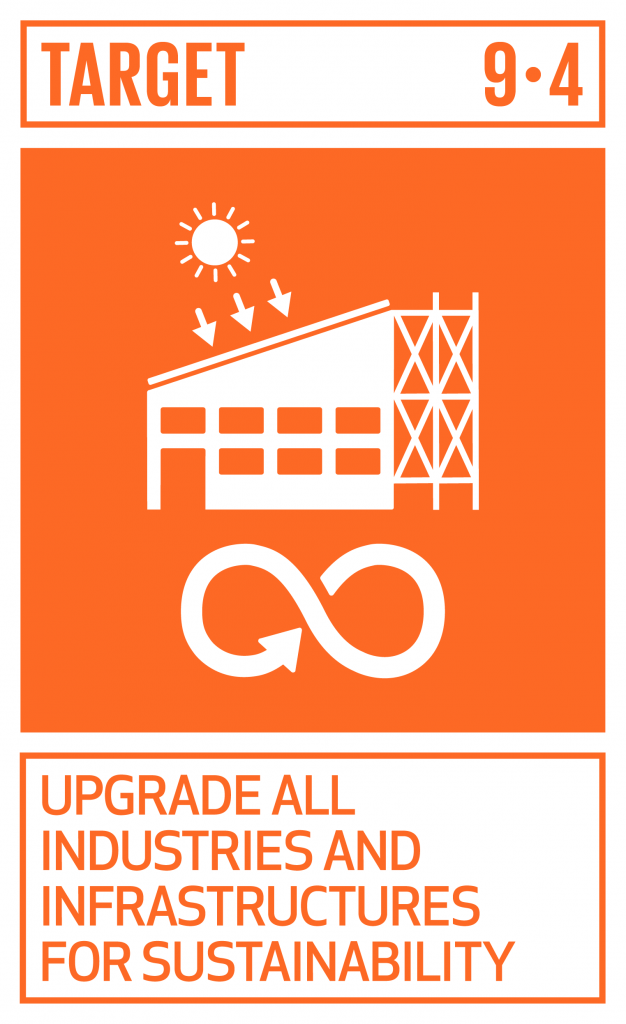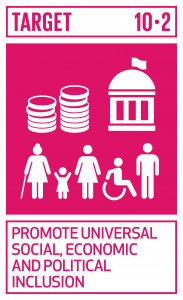Background
This summer, we partnered with our city client, StreetsLA, to imagine equitable solutions to urban design. During our 10 week internship we used sustainable development practices, data, and policy to formulate innovative ideas for street asset investment prioritization.
For this project, our team specifically focused on SDG 9.1 & 9.4, which help further implementation and retrofitting of sustainable infrastructure, SDG 10.2, which seeks to empower the social, economic, and political inclusion of all, and SDG 11.b, which encourages development of integrated city policies to mitigate climate change and promote resilience to disasters. To address these SDGs, our team developed an innovative street asset investment tool, which incorporates socioeconomic and racial equity metrics into the street asset management decision-making process. Historically, street asset investment is based on physical feasibility. Our project, though, goes beyond physical constraints and studies street asset investment in the scope of social demographics and environmental needs of neighborhoods across Los Angeles.
WHAT DOES STREETSLA DO?
StreetsLA is vital to safe streets and a vibrant cityscape in Los Angeles. The Bureau performs a wide range of maintenance activities including pavement preservation, street tree and median maintenance, and street furniture upkeep. In addition to their regular maintenance work, StreetsLA has a number of planning initiatives such as “Great Streets”, which seeks to improve the pedestrian experience by increasing safety at pedestrian crosswalks, installing street furniture, and planting trees to contribute to LA’s urban forest. Given the bureau’s wide range of initiatives, they are responsible for a large number of above-ground sidewalk and transit-related amenities that, in this project, are referred to as ‘street assets.’
Our Process
We divided our project into two distinct workflows––a data stream and a policy stream. On the policy stream, our team members examined different facets of street asset investments across the world, researching case studies from diverse global cities, including Singapore, Lima, and Amsterdam. We also looked at two other West Coast cities: Seattle and Portland. From these case studies, we specifically looked for initiatives and programs that the City of Los Angeles could learn from within the themes of pedestrian safety & accessibility, clean streets, shade equity, bikeability, and asset management.
On the data stream, our team members focused on building a GIS prioritization methodology for the project. Using an equity lens, we gathered socioeconomic data, including the existing deprivation and the displacement pressure indices. Additionally, we included data from the annual count of unhoused persons via LA GeoHub and constructed a vehicle access metric from 2010 Census data for a more comprehensive picture of neighborhoods’ demographic profiles and mobility needs. We used these disparate data sources to create an aggregated socioeconomic index, and then employed a quantile method to assign a score from 1-5 to each census tract; 5 representing the highest investment priority needs based on the socioeconomic index.
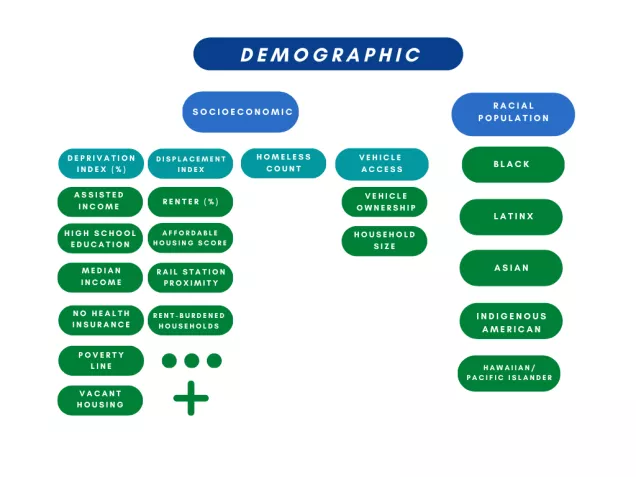
For the street asset data, we sourced data from StreetsLA and LA GeoHub, which is the city’s public open data platform. Because there is such a wide variety of street assets, we grouped them into five thematic categories: bikeability, pedestrian, sanitation (“WASH”), street furniture, and services.
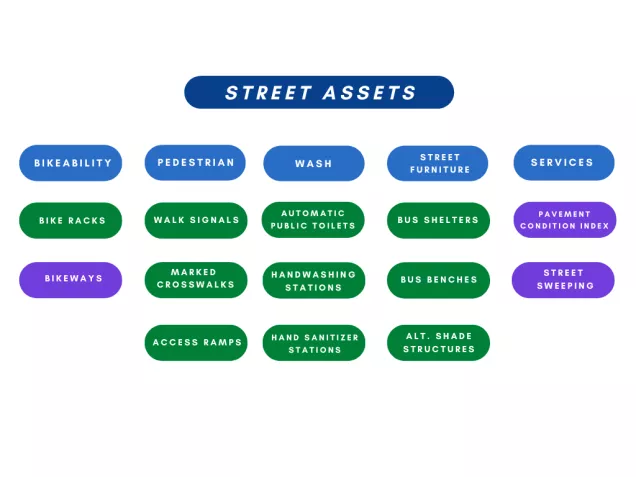
By dividing assets into distinct thematic categories, we were able to identify what types of street assets would be most beneficial in specific neighborhoods. The assets in the green bubbles are visualized as dots or polygons in the data layers and we then computed a priority score based on the values of asset counts within each geographical boundary. On the other hand, the datasets in the purple bubbles are represented as lines in the dataset. We measured the lengths for these line datasets and used percentages for our calculations. For the pavement condition index, we measured the overall length of pavement indexed as ‘poor’ in each census tract and divided it by the total indexed pavement miles in the tract. Census tracts with fewer assets received a higher prioritization score. From the categories listed above, we computed a street asset index score that follows the same logic of the SE scores, ranging from 1 to 5 and indicating an increasing level of need.
VISUALIZATION
We used a relationship map within ArcGIS Online to visualize our socioeconomic and street asset indices against each other. The pink areas are of particular importance, as they symbolize areas that have both high socioeconomic and street index scores, and are thus high priority investment areas.
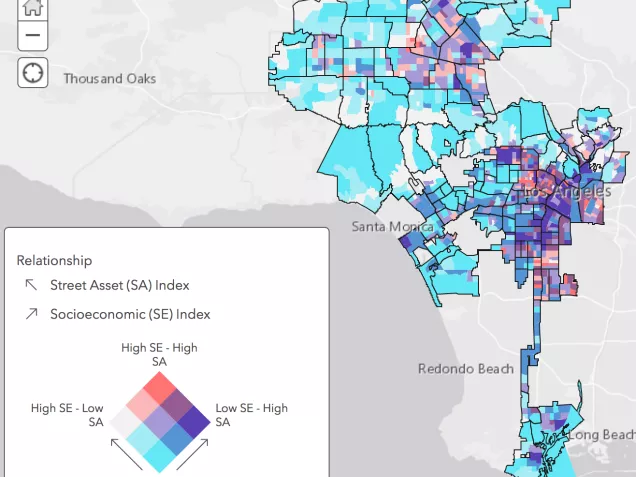
Policy Recommendations
Below are the policy recommendations derived from our research findings and conversations with city clients and experts. Our recommendations align with Mayor Eric Garcetti’s Executive Directives, including those focused on achieving sustainability and equity throughout L.A.
Our recommendations are separated into two categories: Assets and Data.
ASSETS
- Install more bike racks along bike paths in coordination with LADOT and local business owners to determine the need and buy-in for placement
- Establish a process for more frequent pavement condition audits to address disparities in pavement conditions with development projects
- Issue a city-wide, annual springtime street clean up and develop benchmarks for street sweeping operations
- Increase accessibility and availability of public assets related to water access, sanitation, and hygiene
DATA
- Streamline an integrated asset management platform across city departments and bureaus for planning and decision-making.
- Improve data integrity and quality by building out and validating databases on handwashing and hydration stations, APTS, and bus benches, and by using upcoming urban forestry studies to contextualize shade equity and distribution of alternative shade structures
- Introduce weights and priorities into the street asset investment process
- Gather more data that is representative of the demand and need for certain assets and services
- Continue stakeholder groups and generate feedback on development projects through robust processes, like participatory planning and public participatory GIS (PPGIS)
- Establish alternative methods to generate data on demand
- Crowdsourcing through app with volunteered geographic information (i.e Qlue in Jakarta)
- Public-facing surveys (LA Barometer; NDSC)
- Outsourcing to third-party researchers
- Build trust with lower-income communities of color, which could be accomplished through more equitable investment
- Further research to contextualize street asset prioritization with community need using MyLA311 service request data
Methodologies for street asset investment must transcend physical feasibility to include social demographics and economic constraints. Without targeted, intentional investments by StreetsLA, neighborhoods across LA will continue to grow disproportionately. The recommendations above seek to advance the Sustainable Development Goals by re-imagining new pathways for equitable street asset investments.
